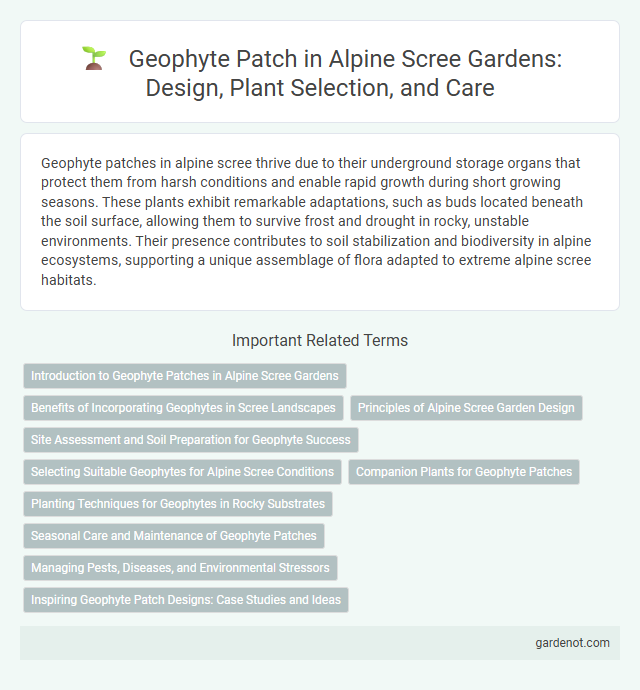Geophyte patches in alpine scree thrive due to their underground storage organs that protect them from harsh conditions and enable rapid growth during short growing seasons. These plants exhibit remarkable adaptations, such as buds located beneath the soil surface, allowing them to survive frost and drought in rocky, unstable environments. Their presence contributes to soil stabilization and biodiversity in alpine ecosystems, supporting a unique assemblage of flora adapted to extreme alpine scree habitats.
Introduction to Geophyte Patches in Alpine Scree Gardens
Geophyte patches in alpine scree gardens are specialized plant communities composed of bulbous, tuberous, or rhizomatous species adapted to survive harsh mountain conditions. These plants thrive in loose, rocky substrates with excellent drainage, benefiting from seasonal fluctuations in temperature and moisture that mimic their natural high-altitude habitats. Characteristics such as underground storage organs and early spring growth enable geophytes to complete their life cycles efficiently in alpine scree environments.
Benefits of Incorporating Geophytes in Scree Landscapes
Incorporating geophyte patches in alpine scree landscapes enhances biodiversity by providing crucial early-season nectar sources for pollinators and stabilizing soil through their specialized underground storage organs. These plants improve ecosystem resilience against harsh alpine conditions, optimize moisture retention, and contribute to nutrient cycling in nutrient-poor scree environments. The presence of geophytes also promotes microhabitat diversity, supporting a wider range of flora and fauna adapted to alpine scree ecosystems.
Principles of Alpine Scree Garden Design
Geophyte patches in Alpine scree gardens emphasize well-drained, gritty substrates that mimic natural scree conditions, ensuring bulbs and tubers receive optimal moisture without waterlogging. Planting clusters at varied depths and incorporating rocks or gravel supports root stability and microclimate regulation, crucial for geophyte survival in harsh alpine environments. Designing these patches with layered spatial arrangements enhances biodiversity and visual interest while maintaining ecological authenticity.
Site Assessment and Soil Preparation for Geophyte Success
Site assessment for successful geophyte establishment in alpine scree involves analyzing soil pH, moisture retention, and nutrient content to mimic natural conditions. Proper soil preparation requires loosening compacted scree substrate and incorporating organic matter to improve aeration and water drainage. Selecting microhabitats within scree slopes with optimal sunlight exposure and minimal erosion enhances geophyte survival and growth.
Selecting Suitable Geophytes for Alpine Scree Conditions
Selecting suitable geophytes for alpine scree conditions involves prioritizing species with high tolerance to poor soil drainage, extreme temperature fluctuations, and limited nutrient availability. Bulbous plants such as Crocus albiflorus and Erythronium dens-canis demonstrate robust root systems and dormancy cycles ideal for rocky, well-drained substrates typical of alpine scree environments. Efficient water storage and resistance to mechanical disturbances from scree movement are critical adaptive traits for sustainable growth in these harsh mountainous terrains.
Companion Plants for Geophyte Patches
Companion plants for alpine scree geophyte patches often include low-growing species such as Saxifraga oppositifolia, Eritrichium nanum, and Androsace alpina, which thrive in rocky, well-drained soils. These plants contribute to soil stabilization and microhabitat creation, enhancing water retention and nutrient availability essential for geophyte bulbs like Narcissus and Crocus species. The presence of mosses and lichens further supports geophyte patches by maintaining moisture and protecting delicate root structures.
Planting Techniques for Geophytes in Rocky Substrates
Planting geophytes in alpine scree requires careful placement in crevices filled with well-drained, gritty soil to mimic natural conditions. Using a mixture of coarse sand, gravel, and organic matter ensures adequate drainage and protects bulbs from rot in rocky substrates. Shallow planting depths, typically 2-3 times the bulb's height, promote healthy root development and prevent waterlogging in these challenging environments.
Seasonal Care and Maintenance of Geophyte Patches
Seasonal care of alpine scree geophyte patches involves minimal disturbance to the soil to preserve bulb integrity and promote natural growth cycles. Regular monitoring during spring and autumn ensures timely removal of dead foliage and prevents fungal infections, while avoiding excessive watering maintains optimal moisture balance crucial for bulb development. Mulching with organic material during winter provides insulation against frost, supporting geophyte survival and robust seasonal regeneration.
Managing Pests, Diseases, and Environmental Stressors
Geophyte patches in alpine scree environments require targeted management strategies to mitigate pests, diseases, and environmental stressors that threaten plant health. Implementing regular monitoring protocols helps detect early signs of fungal infections and insect infestations specific to high-altitude flora. Employing natural pest predators, resistant cultivar selection, and microhabitat modifications can enhance geophyte resilience to extreme temperature fluctuations, soil erosion, and pathogenic pressures.
Inspiring Geophyte Patch Designs: Case Studies and Ideas
In alpine scree environments, geophyte patches showcase resilient plant species adapted to harsh conditions, offering inspiration for sustainable garden designs that mimic natural rock and soil dynamics. Case studies reveal how integrating native bulbs such as Erythronium and Trillium into well-drained scree beds fosters vibrant seasonal displays and biodiversity. Emphasizing microhabitats with varied substrate textures enhances growth success, guiding landscape architects towards innovative, ecologically sound scree-inspired garden solutions.
Geophyte patch Infographic

 gardenot.com
gardenot.com